FOR THE BEGINNING AUTOMOTIVE ART COLLECTOR
Reading this won’t qualify you for a BFA, but you’ll know more than you knew before… and it will be very helpful to those looking to buy automotive art but don’t know a Giclee from a Gouache. Before embarking upon a trip to Monterey, save this article on your hand held! Wallace Wyss leads us through the maze.
By Wallace Wyss
Most people think “automotive art” and think of posters, the type they hand out at car shows with pretty girls sitting on the fender of a low rider ’55 Chevy. But automotive art is part of the art world in general, so I have volunteered this little glossary for a quick up-date on what you will see at the next concours selling fine art.
ABSTRACT Also called non-figurative painting, generally relies on colors, lines, and shapes instead of recognizable images or symbols for its compositional elements, hence not too popular in automotive art where we want to see something that looks like our favorite car.
ACRYLIC Basically it’s a fast drying paint made from pigments suspended within an acrylic polymer emulsion. If you thin out the paint with water while painting looks like a watercolor but if you don’t thin it, it looks like an oil painting. It does not mix well with regular oil paint.
ANALOGOUS COLOR Closely related hues, especially those in which you can see a common hue; hues that are co-exist happily on the color wheel, such as blue, blue-green, and green.
ALUMINUM PRINT This is a relatively new printing process in which you can print the image of a painting or photograph on brushed aluminum. These are also called “metal prints”.
ART DECO An eclectic form of stylish modernism based on mathematical geometric shapes. Art Deco was a popular international design movement from 1925 until 1939. A lot of classic cars of the late ‘30s were “art deco” inspired, very streamlined and forward looking.
ARTIST’S PROOF Sometimes when an artist is doing a print by a mechanical process, they stand there and watch them come off the press, and judge if they are satisfied with the results. If not, rather than throw away the ones that have too much of one color or another, these are signed “artist’s proof” rather than numbered serially as they have no intention of making more as the final print. It’s a bit like buying “pre-production” car from an automaker, when the production one had a lot of changes from the one you’re buying.
ASYMMETRICAL Usually the composition is “weighed” to even out, something on one side balanced with something on the other but occasionally it is far more weighted toward one end than the other to achieve some specific effect so we call it asymmetrical.
CHARCOAL Historically used in painting to sketch the composition layout prior to painting, but also used to make complete works. Charcoal is available in vine, compressed, and powdered forms
COLOR WHEEL If you are wondering what color harmoniously goes with another color, (i.e. complementary) this wheel, which you can buy at any art store, shows all the popular colors contiguous to each other so you can see which ones to select without a jarring clash. It’s also a clue as to which colors to mix to make a color you don’t have a tube of, such as red and blue to make violet.
CONSTRUCTIVISM A modern art movement beginning in Russia that aimed to create abstract sculpture for an industrialized society. The movement utilized technology and building materials such as glass, plastic, steel and chrome. One current artist specializing in this is Art Center teacher Richard Pietruska. (rpmart.com)
CUTAWAYS These are essentially X-ray views. Three are only a few cutaway artists left, because it takes weeks to do such a drawing; some of the artists even go to where the car is built and draw it layer by layer. Many of the drawings are used in ads and in press releases.
EDITION An edition of a print would be all those impressions printed at the same time or as part of the same publishing event. A first edition print is one which was issued with the first published group of impressions. First edition prints are sometimes pre-dated by a proof edition.
EMBELLISH To add paint or other artist’s medium to a previously finished work, for instance an “embellished giclee” is a printed on canvas print that an artist embellishes with oil all over again as if it is a new painting, though sometimes it can be minor embellishments, a touch here and there. It is a way for an artist to sell a print to someone who can’t afford an original but wants a print that looks like an original.
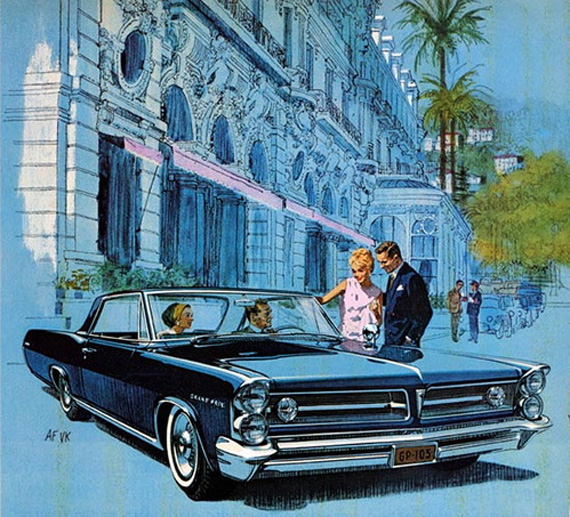
This ’63 Grand Prix drawn by Van and Fitz was part of a multi-year campaign to use artwork to sell the European flavor of Pontiacs instead of photographs. They are amusing today because of how much they distorted the cars to make the cars look wider, lower and longer. Originally this illustration was commissioned commercial art but now could be considered fine art if framed without the words.
FINE ART This one you could argue about forever but for our purposes here, it is art created to be art, not created to be used in a car ad, i.e. to be subject to selling some product with room for headlines and body copy. As opposed to “commercial art” though commercial art, with the passage of time, can become “fine art.”
FOCAL POINT the one area on the artwork where your eye is led to. Usually the focal point is where everything is most tightly in focus. On some paintings the car loses detail as you go further out from the focal point.
GICLEES (pronounced GHEE-CLAYS) These are prints that can put on canvas, transferred electronically, or on paper. They can also be embellished with oils or watercolors after printing to make each print slightly different from the others done in the run.
GLAZING The process of applying a transparent layer of oil paint over a solid one so that the color of the first is profoundly modified. Some folks like a glaze laid over a new oil painting so it “looks more antique.”
GOUACHE Similar in looks to watercolor but more opaque and reflective in nature due to white chalk in the paint.
HISTORICAL PAINTING These could run from impressionistic like some of Walter Gotschke’s Formula 1 paintings to super-realistic in style but the predominant purpose is to depict a moment in a narrative story, rather than a specific and static subject, as in a portrait. For instance, James Dietz sometimes portrays classic cars at a significant race, and is famous in the military painting world for his paintings of the First and Second World Wars.
HYPER REALISM Also called Super-realism, see below
IMPRESSIONISTIC This was the opposite of super-realism where the artist just wanted to capture the essence of a car or a car event without getting specific on any details of the car. In France, in the 19th century there was a whole school of “Impressionists”.
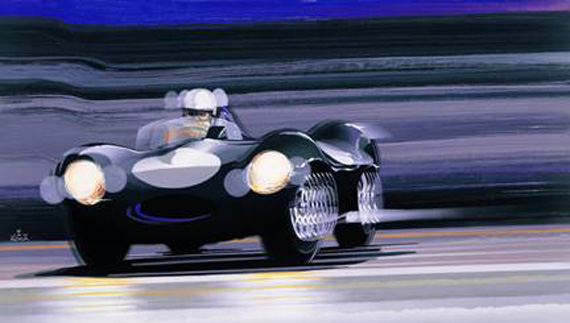
Jay Koka’s “The Drift,” showing a racing Jag in a full four wheel drift, is impressionistic but far more satisfying than just another photorealistic look at the car.
LIMITED EDITION I went to Philaprintshop.com for their definition:
“A limited edition print is one in which a limit is placed on the number of impressions pulled in order to create a scarcity of the print. Limited editions are usually numbered and are often signed. Limited editions are a relatively recent development, dating from the late nineteenth century. Earlier prints were limited in the number of their impressions solely by market demand or by the maximum number that could be printed by the medium used.”
Ironically in the old days you could only make so many and maintain quality,( such as in engraving: 500) , but with the development of lithography and of steel-plates you could make 10,000 or more without a loss of quality which led artists to come up with the idea of bringing back limited edition prints, to guarantee rarity and individuality for multiple impressions of their art.
LITHOGRAPHED POSTERS These are printed the traditional way with a lithograph machine. Usually four color (which means all the colors, it’s just that all the colors are mixed from the same basic four).
MIXED MEDIA These occur when an artist is trying to salvage a work he or she has already invested some time in. I remember when my employer, an ad agency, hired Dallison to do a Corvette illustration and he didn’t like the background after he had done the car so he took a scissors and cut the car out and started a new background, pasting the Corvette on top of the drawing. So you are mixing media. Sometimes when it’s a far different media, like paper drawing glued onto wood, it’s a “collage.”
MONOCHROMATIC These are seldom seen because we have four color printing readily available, but basically they are a reduction of the color palette to compatible colors that are all in the same color range (all in the same area of the color wheel).
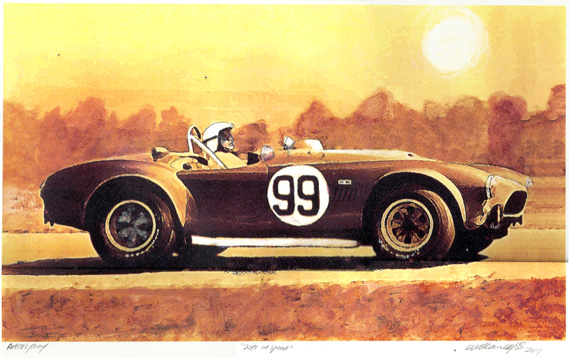
This painting by Wallace Wyss of a racing 289 Cobra is an exercise in going monochromatic. It was more difficult to paint using variations of one color than it would have been to do it full color.
NUMBERED EDITION When the artist planned to only make a certain number, i.e., a limited edition. So if he printed only 100 they would be numbered 1/100 and so forth. The more exclusive the edition, theoretically the more the print is worth.
OIL PAINTINGS These are the most traditional, oils on canvas, and are long lasting. Oils range from about $150 on up to a handful in the millions, depending on the artist’s reputation. I would value an original at far more the cost of a print because there can only be one original. Once it’s sold, it’s sold. Even if you print giclee copies of it that look exactly like it, those are only reproductions.
ORIGINAL PRINT Again I quote from the experts at Philaprintshop.com:
“An original print is one printed from a matrix on which the design was created by hand and issued as part of the original publishing venture or as part of a connected, subsequent publishing venture. For fine art prints the criteria used is more strict. A fine art print is original only if the artist both conceived and had a direct hand in the production of the print. An original print should be distinguished from a reproduction, which is produced photomechanically, and from a restrike, which is produced as part of a later, unconnected publishing venture.”
This author thinks their definition a bit too confining now that we have computers directing the printing but I still think a print that was made with the artist right there by the machine at the printer supervising the printing is buying art more connected to the artist’s original goal for the work.
PASTEL Making art with permanent-colored sticks. When the ground is completely covered with pigment, the work is considered a pastel painting; leaving much of the undersurface exposed. Must have fixative spray applied to prevent smearing.
PLEIN AIR French for “fresh air” and refers to
landscapes painted outdoors with the hope of catching that open air. Very few automotive artists paint on the spot but it’s a thrill to see artwork be created on a plain canvas in one take.
POP ART This 20th century art movement used techniques of pop culture — like comic books — in an affront to traditional tastes. Ironically the most expensive automotive art is the pop art created by Andy Warhol, who it is said didn’t even drive.
PROMO POSTER A poster done using artwork to promote a specific event, such as a concours or an artist appearance at the concours. In a way it’s less “pure” being in a sense an ad, but in another way it is prized because commemorates the event, such as the coveted Pebble Beach posters. Much sought after are Bagatelle concours posters by Razzia.
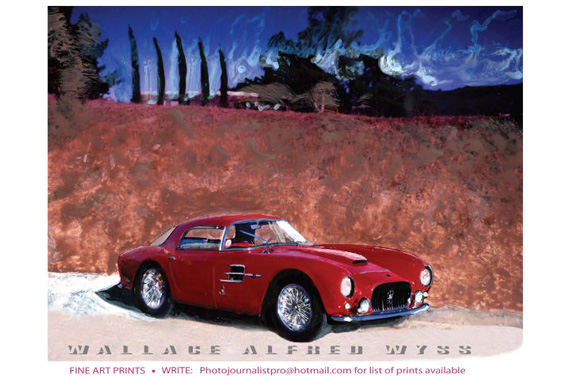
Promo posters are more commercial art in that they are made to promote a certain event. Still, if the event is worth commemorating, it can be a great souvenir. This one promotes the artist.
SCREEN PRINTS Andy Warhol, once a commercial artist, perfected the mass reproduction of fine art prints, some of them embellished after printing. He produced them in a building he called “the factory” and is famous for using “found” black and white images of photographs of cars and adding color seemingly slap-dash when he went to the silk screen print. Some of his documented screen prints have sold for over one million.
SEPIA TONED Black and white photographs in the old days were dipped in a sepia bath resulting in shades of warm browns. Because this photographic technique was used extensively in the past it often evokes a vintage feel and is used in some paintings made today.
SUPER REALISM This was an art trend that had paintings look like photographs.
SURREALISM The most famous artist was Salvador Dali; beginning in 1920s, the Surrealist art movement combined super-realism with a distortion of reality.
TECHNICAL DRAWING These are commercial art originally done for the coachbuilder or automaker similar to a blueprint for a building, with all sorts of measurements on them. The customer for a coachbuilt car may never see this drawing. Folks who gravitate toward this type of automotive art are architects, and car restorers.
WATERCOLORS There are several artists like Ken Dallison, who excel at watercolor portraits not only of the cars but of the settings you find classic cars displayed.
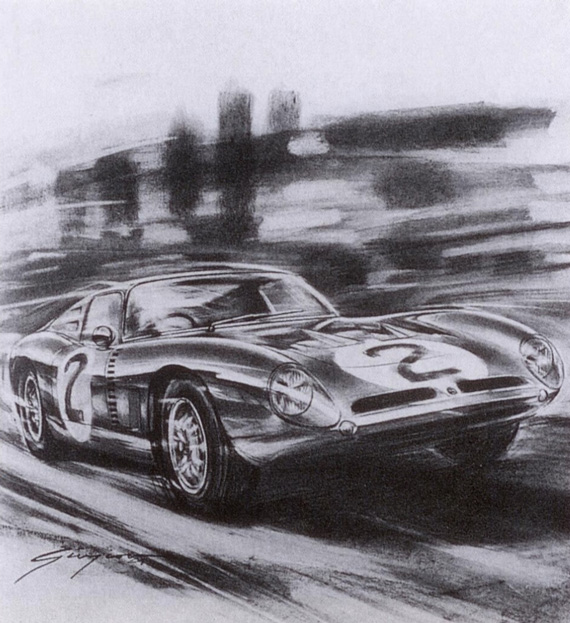
A drawing from an automaker’s files would be worth its weight in gold if it was the original. Still a nice reproduction is worth something especially if you can get the original artist to re-sign it. This is Giugiaro’s drawing of the Iso Grifo A3/C.
WORK DRAWING Rarely is an artist’s work drawing sold; because these are only preliminary sketches in which they are blocking out the composition; what’s in the foreground, what’s in the background, maybe what colors will be used. But sometimes they sell them and these can be really collectible if the final painting is well known or if sketches from the artist are hard to find. Particularly interesting in the car field are the first working drawing sketches of a new design from a name auto designer like Giugiaro, Michelotti, or American automaker designers who were usually forbidden to take their renderings home. (nonetheless there have been exhibits in Detroit of automaker art).
WATERCOLORS There are several artists , like Ken Dallison, who excel at watercolor portraits not only of the cars but of the settings you find classic cars displayed.

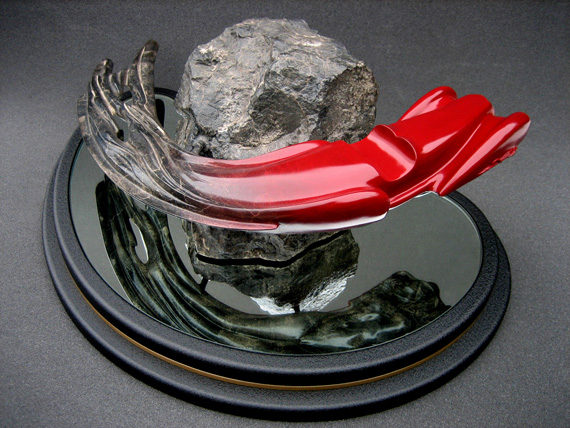
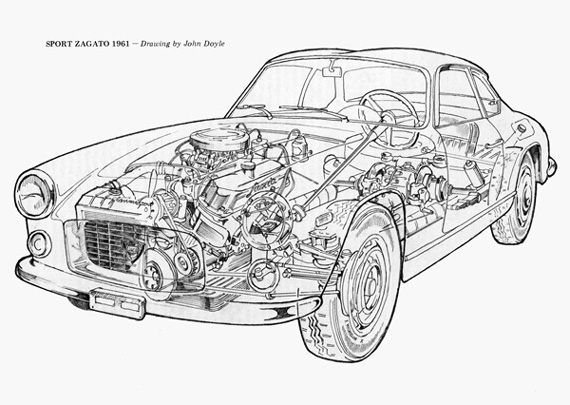
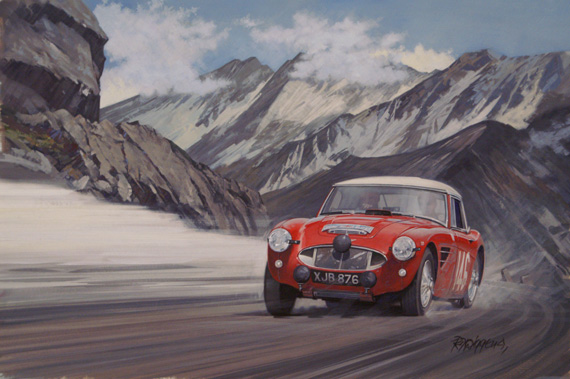
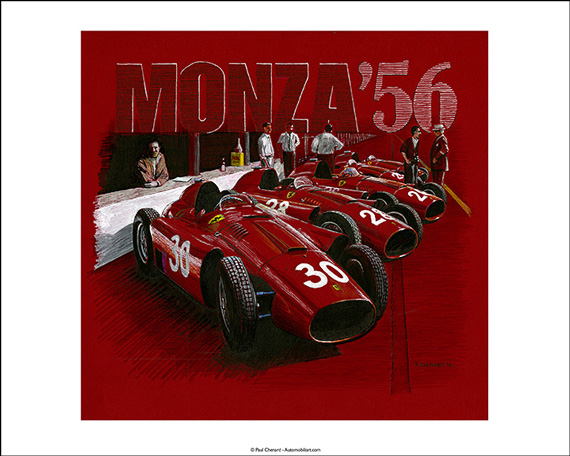

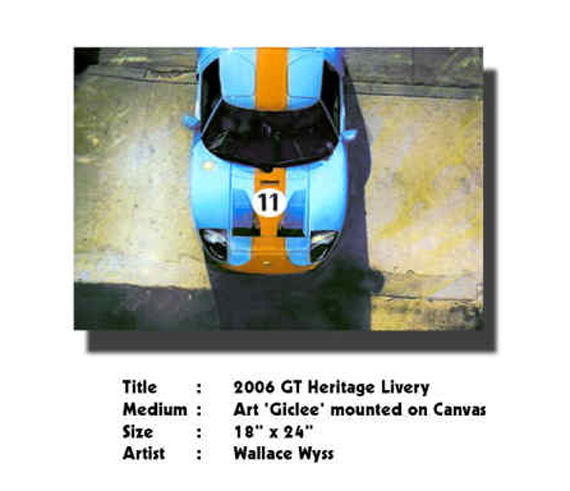
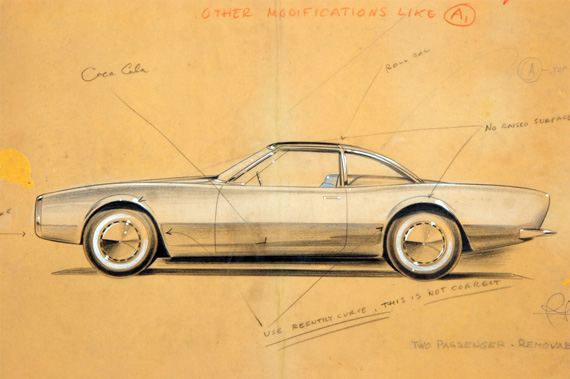
A very useful guide to some of the terminology that I often read, but not being much of art student, did not always understand; giclee, gouache and especially the different terms for editions, limited editions or numbered editions. By the way, I have always liked the Pontiac art of Art Fitzpatrick and Van Kaufman and have collected a run of the brochures through the ’60s on to ’71. I believe Art usually did the cars on a background by Van. Great images of a time now passed. Thanks for the info above.